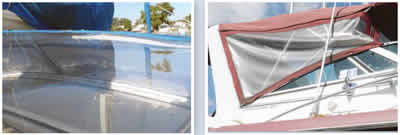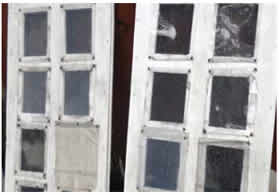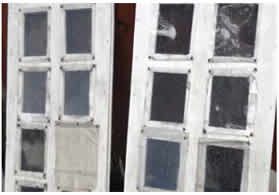
The Strataglass users maintenance guide states the following: We recommend using only Imar Products. Imar Strataglass Protective Polish, Imar Strataglass Protective Cleaner, and mild soap (preferably Imar Yacht Soap Concentrate) on Strataglass. We no longer recommend the use of any other products, regardless of the manufacturers claims. Use of harsh cleaners like Simple Green and/or pine will dull the curtains quickly. Using any other product(s) void the factory warranty. The guide further warns: Use of RAINEX, Pledge, or Plexus on Strataglass appears to work for a short time but then dulls the surface and presents an Orange Peel effect. Do not use any of these products.
Use of cleaners, polishes, scratch removers, or any other product made for regular, un-coated vinyl will damage Strataglass. Do not use these products.
Strong words born of many bad experiences, no doubt. OSullivan Films, the maker of OSea and Regalite vinyl, offered similar cautions, though not as a formal part of their warranty requirements.
While manufacturer guidance should always be heeded, we have made a few observations of our own and offer this roundup of best practices for maintaining vinyl.

Chemicals
There are many common boating chemicals that can ruin vinyl windows and are rough on other plastics:
Sunscreen: Sunscreen handprints on vinyl are difficult or impossible to buff out. Sometimes, the handprints occur when a guest helps roll up the windows, and you may not see the prints until the next morning, when dew develops them, inside the vinyl. Keep a washcloth handy for wiping hands, or better, wash hands before touching the clear vinyl.
Insect repellent: DEET will melt vinyl. Even a fine spray will haze many plastics. We recommend politely asking guests to use insect sprays well outside of the cockpit area, away from all windows, and to wipe or wash their hands thoroughly when finished. Consider banning aerosol repellents from your boat.
Vinegar: If rinsing your vinyl windows with fresh water and polishing them with a spray polish does not remove all of their spots, the spots are very likely calcium deposits. Use a 10-percent solution of vinegar and water to clean them, rinse thoroughly after use, and apply a protectant.
Canvas water repellents: As we reported in the December 2013 issue, some canvas waterproofing treatments are quite tough on vinyl and can ruin it within minutes. (The runoff of most water repellents is widely suspected of causing hazing over time, something we will be looking into.) If you treat your canvas, be certain to apply a fresh protectant coat to the windows before you begin, cover the windows first and wipe the vinyl with a cleaner/protectant as you go.
Silicones and solvents: All manufacturers advise against using products on vinyl that contain silicones, petroleum solvents, or alcohols. Small amounts of certain alcohols are permitted in some cleaners but not the use of alcohol-based glass cleaners.

Covers
The benefit of covering your clear-vinyl windows is positive protection from harmful UV and dirt. The downside, other than the cost and the time to remove and replace each time you take the boat out, is the risk of abrasive wear between the cover (typically Sunbrella) and the window. Weve heard of folks using Phifertex material and finding that their windows have a fine checkerboard pattern within six months (vinyl and polycarbonate). Weve also heard reports of damage in windy harbors from the covers constant flapping; in the wind, the best solution seems to be consistent cleaning and use of protectants.
Some folks use Sunbrella with an integral lining, but dirt can imbed in the lining, resulting in worse abrasion than plain fabric. Wear is very often related to the size of the dirt particles, and lined Sunbrella can hold larger particles than unlined Sunbrella.
For skylights, we have had very good luck with simple Sunbrella covers. Sure, they get dirty, but there isn’t enough flapping to cause any wear, and any dirt particles they carry are super fine and do no damage. These same covers have worked on rigid polycarbonate and acrylic hatches and windows, which are naturally less scratch-prone.
For the best of both worlds, we suspended awning covers over the dodger windows. Theres no chance of abrasion even if the window is salt- and dirt-encrusted; UV and bird bombs are blocked; and they can even provide expanded shade and reduce the need to close the windows for a passing shower at anchor. Yes, they have to be removed for sailing, but time spent cleaning windows is mostly eliminated, resulting in a net labor savings. While these covers have survived tropical storms, they might not fare well in windy harbors. There simply is no one-size-fits-all solution.
Cleaning
Use only soft polishing cloths to clean clear vinyl. Clean cotton jersey (T-shirts or polishing cloths) are safe, but paper towels may leave scratches (grit left over from the paper-making process is much harder than vinyl). Microfiber cloth is a favorite as well, but it must be kept very clean as it quickly attracts dirt.
Rinse the windows with water before polishing, and change to a fresh cloth every 5 to 20 square feet, depending on how clean the window was at the start. Turn the cloth frequently.
Storing the windows
Only roll up vinyl windows when they-and your hands-are clean. Salt spray is abrasive and can cause minor scratching. Its better to squint through salt-encrusted vinyl until a freshwater rinse is practical than to have your view blocked by scratches for years to come. Alternatively, remove the window panels. If youre rolling up the windows for storage, roll them with soft, clean fabric to keep the vinyl from touching itself and potentially adrading the surface.
If you plan to roll up your windows regularly, youll likely be happier with a thinner vinyl material (30 mil vs. 40 mil) or more flexible products (OSea and Regalite, vs. the stiffer Strataglass) since less force is required and less scratching results.
Colder weather
While many folks put their boats away for the season as soon as they need socks, some sail into the fall or even year-around; the further north, the greater the urge to stretch the season. As temperatures plummet, we become more and more accustomed to the chill, and by January, some think 32 degrees is quite comfortable for a day on the water, if dressed for it. However, vinyl does not acclimate, and depending on the gauge-thicker is stiffer and more vulnerable-rolling or flexing old vinyl windows at temperatures below 60 degrees is just asking for trouble. The more worn and hazed the windows become, the greater the urge to clear the view by rolling them out of the way, and suddenly the window has a crack running halfway across. A good rule of thumb is to wait to roll windows until hats and gloves are forgotten (over 60 degrees). If there is dew or frost on the windows, wait for the sun to remove it.
Scratch removal products
Our early testing suggests the actual vinyl-restoration process might compromise the materials protective coatings and lead to premature weathering, even if applied to just a few scratched areas. Weve added some restored windows to our long-term test racks, but it is clearly better to keep windows scratch-free and UV protected than to restore damaged vinyl.
If your vinyl windows have some damage or weathering, and standard cleaning and polishing is not doing the trick, try laying them on a flat, towel-covered surface and polishing very firmly with Imar Protective Polish. This was nearly as effective in removing light oxidation and providing deep cleaning as the polishing, without the risk of abrasion or coating degradation.





































In my cruising grounds (upper Great Lakes), the clouds of vicious evening mosquitoes have made the full canvas enclosure a standard feature on cruising boats (and powerboats). I personally despise canvas enclosures: the look, the weird, airless feel of being inside it, the water and bug leakage, the the dodgy plugging of gaps with towels, the insane effort to remove or erect it, its damage-prone nature. Because of the latter 2 reasons, virtually all boats leave it up all season, which is even worse.
I solved this by searching out a pilothouse boat with opening windows and screens and another steering station in the open cockpit. These boats are treasured in the Pacific north-west and the North Sea area – why not here? I just don’t get it. Solves all the problems and adds none. And please don’t give me that ‘windage’ speech from that very draggy, always-up full-enclosure that ruins any sleekness and sailplan utilization of your ‘sporty’ cruiser-racer-styled boat.
And the view from the mini-salon in the PH makes it the best place on the boat to hang out.
I would also recommend using the Clearstow boat curtain storage bag for stowing curtains when not in use